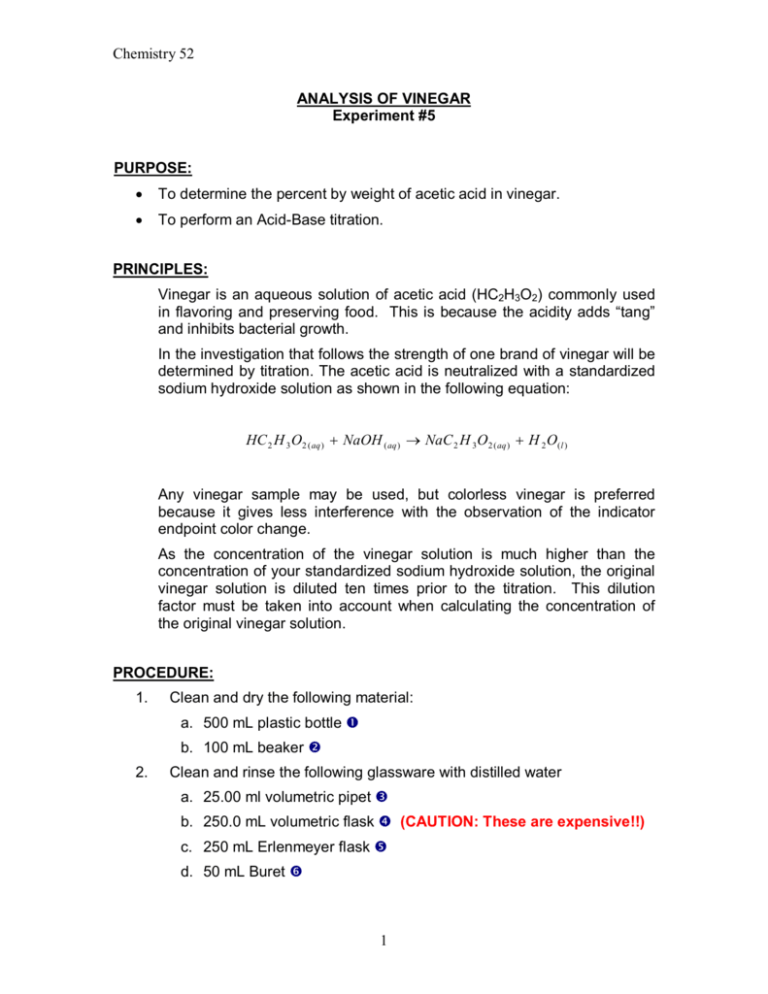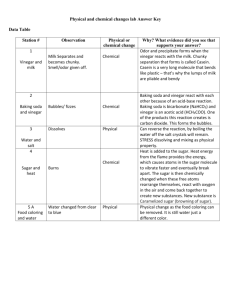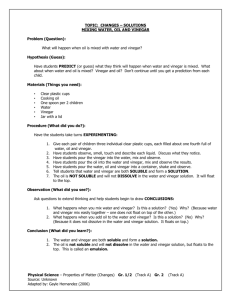Chemistry 52 1 ANALYSIS OF VINEGAR Experiment #5 PURPOSE
advertisement

Chemistry 52 ANALYSIS OF VINEGAR Experiment #5 PURPOSE: · To determine the percent by weight of acetic acid in vinegar. · To perform an Acid­Base titration. PRINCIPLES: Vinegar is an aqueous solution of acetic acid (HC2H3O2) commonly used in flavoring and preserving food. This is because the acidity adds “tang” and inhibits bacterial growth. In the investigation that follows the strength of one brand of vinegar will be determined by titration. The acetic acid is neutralized with a standardized sodium hydroxide solution as shown in the following equation: HC 2 H 3 O 2 ( aq ) + NaOH ( aq ) ® NaC 2 H 3 O 2 ( aq ) + H 2 O ( l ) Any vinegar sample may be used, but colorless vinegar is preferred because it gives less interference with the observation of the indicator endpoint color change. As the concentration of the vinegar solution is much higher than the concentration of your standardized sodium hydroxide solution, the original vinegar solution is diluted ten times prior to the titration. This dilution factor must be taken into account when calculating the concentration of the original vinegar solution. PROCEDURE: 1. Clean and dry the following material: a. 500 mL plastic bottle Œ b. 100 mL beaker • 2. Clean and rinse the following glassware with distilled water a. 25.00 ml volumetric pipet Ž b. 250.0 mL volumetric flask • (CAUTION: These are expensive!!) c. 250 mL Erlenmeyer flask • d. 50 mL Buret ‘ 1 Chemistry 52 3. Measure exactly 25.00 mL Ž of vinegar into a clean 250.0 mL volumetric flask •. Notes: ­ Be sure to use a dry beaker to transfer the vinegar. ­ Do not put any used vinegar back in the vinegar supply. ­ Be sure to rinse your pipette with vinegar prior to using it. 4. Dilute the vinegar with deionized water to the mark on the volumetric flask •. 5. Stopper the flask • and mix the solution well. (Invert the solution slowly for at least 10 times to completely mix the contents). 6. Transfer the dilute vinegar solution to a clean and dry 500 mL plastic bottle Œ and label it with both the contents and your name. 7. Immediately wash your volumetric flask • with plenty of tap water and several portions of deionized water. Let the flask dry at room temperature. 8. Pour about 50 mL of the dilute vinegar solution in your 100 mL beaker •. 9. Rinse your 25.00 mL volumetric pipet Ž several times with portions of diluted vinegar from your beaker. Be careful not accidentally add any water to the diluted vinegar solution in the beaker. 10. Carefully pipet 25.00 mL Ž of diluted vinegar solution into the 250 mL Erlenmeyer flask •. 11. Add about 50 mL of deionized water to the Erlenmeyer flask •. 12. Add 2 drops of phenolphthalein indicator solution and swirl the flask to thoroughly mix the solution. 13. Rinse your 50 mL buret ‘ several times with a few milliliters of your standardized sodium hydroxide solution. 14. Fill the buret ‘ with your standardized sodium hydroxide solution. a. Make sure that the tip does not have any air bubbles. b. Record the volume or the buret to the nearest 0.01 mL. 15. Titrate the acid sample to a faint pink end point. 16. Record the final volume of the buret to the nearest 0.01 mL. 2 Chemistry 52 17. Repeat the titration procedure described above for at least two more trials. The number of trials run depends on: a. How much standardized sodium hydroxide solution you have available b. The precision of your data. CALCULATIONS: Moles of base = (Molarity of base ) ´ (Liters of base ) Moles of acid (diluted vinegar ) = Moles of base Molarity of Diluted Vinegar = Moles of acid ( diluted vinegar ) Liters of acid ( diluted vinegar ) The MOLARITY OF THE ORIGINAL VINEGAR SOLUTION can be found by keeping in mind that the vinegar has been diluted ten times (from 25.00 mL to 250.0 mL) to obtain the DILUTED VINEGAR, whose molarity has been determined by titration with standardized NaOH. Gramsof HC 2 H 3 O 2 mol HC 2 H 3 O 2 g HC 2 H 3 O 2 L vinegar mL vinegar = ´ ´ ´ Grams of vinegar L of vinegar mol HC 2 H 3 O 2 mL vinegar g vinegar Density of vinegar = 1. 0052 g / mL % Weight HC 2 H 3 O 2 Grams of HC 2 H 3 O 2 = ´ 100 Weight vinegar Grams of vinegar 3 Chemistry 52 Name:______________________ EXPERIMENT #5 REPORT FORM Molarity of Standardized NaOH solution: M Final buret reading (mL) First __________ TITRATIONS Second Third __________ __________ Initial buret reading (mL) __________ __________ __________ Volume of titrant (mL) __________ __________ __________ __________ Moles NaOH used (mol) Show one sample calculations below: __________ __________ __________ __________ __________ __________ __________ __________ Molarity of acid (M) __________ (diluted vinegar Show one sample calculations below: __________ __________ Average molarity of acid (M) (diluted vinegar) __________ Moles of HC2H3O2 used Volume of acid used (L) (diluted vinegar Deviation êdi ê __________ __________ Mean deviation __________ Relative Mean Deviation, RMD Molarity of original vinegar (M) (before dilution) __________ __________ Weight of HC 2 H3 O 2 , % Weight of vinegar __________ 4 __________






